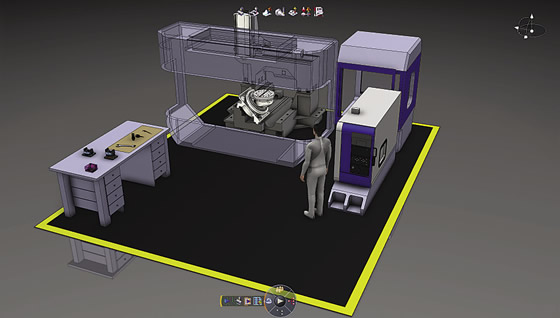It’s quite common for CAM software to come with built-in simulation to identify potential collisions and optimize virtual machining. However, most versions don’t deliver the experience of programming in the context of the NC machine and instead rely on third-party machine simulation to connect the processes. To visualize a toolpath simulation in the context of the NC machine, the programmer must transfer a machine code (ISO or G code) generated from a post-processor to the simulation software.

All images courtesy Dassault Systèmes
The NC programmer has access to the entire machine with the kinematics, a virtual controller and the post-processor within the same programming environment.
If the third-party software reveals a problem, the programmer must retrieve the operation in the CAM software, correct the fault and transfer it again for a machine-context simulation. Because an NC program can easily be thousands of lines long, the iterative process can be frustrating and time-consuming, resulting in costly production delays. Aside from dramatically increasing programming lead time, this approach adversely impacts data integrity as it is translated and requires the programmer to learn multiple user interfaces.
The answer is a strategy that integrates NC programming and simulation of an NC machine’s resources. Integrated programming and simulation means the NC programmer has access to the entire machine, with the kinematics, a virtual controller and the post-processor available in the same programming environment. This level of integration provides full associativity between machining operations, G codes and the designed part, effectively ensuring complete traceability of changes. This eliminates the need to translate and transfer data to third-party systems and provides machine simulation within the programming environment.
With integrated machine programming and simulation, programmers can virtually analyze the job setup, machine accessibility and reachability, and all machine accessories, while validating cutting tool assemblies. Compare this to a typical shop floor scenario where, to validate a setup, the programmer typically has to stop the machine, set up the job and determine a way to study the work envelope.
If programmers can simulate the toolpath within the context of the machine tool upfront, they can program faster with fewer errors. This mitigates toolpath rework and iterations. To help reach this goal, Dassault Systèmes’ DELMIA machining application, which is part of the company’s 3DExperience software platform, integrates and manages products, processes and resources as database objects instead of files.
This single platform allows companies to capture and reuse their machining intellectual property across extended and multiple-site enterprises, providing data security and integrity, accountability and accessibility. This improves the company’s productivity by enabling programmers across the enterprise to collaborate and create valid machine programs in a 3D environment that simulates exactly how machines will behave on the shop floor.
With an integrated approach to programming and simulation, upfront verification during programming can help reduce the programming lead time compared to traditional iterative programming.
The major benefits of an integrated machine programming and simulation strategy include:
■ Time savings. Because there is no need to transfer files to and from third-party machine simulation software, iterative processes and wait times are eliminated.
■ Virtual validation. By resolving issues in the program in the virtual world, programmers can be assured their toolpaths are error-free and that the program will work right the first time on the shop floor.
■ Reduced production time and costs. By reusing optimized toolpaths and associated parameters captured in process knowledge templates, programmers can see increased productivity and sustained quality, while mitigating the risk of programming delays.
With increasingly complex 5-axis and mill/turn machines, integrated simulation can contribute to NC machine programming efficiencies. A recent DELMIA customer noted this approach resulted in faster simulation and machining times, allowing the company to reduce the CNC programming process by 20 percent and mill high-precision molds within 24 hours of software installation. Also, this integrated approach can require fewer prototypes, reduce rework costs and shorten time to market. CTE
Related Glossary Terms
- computer numerical control ( CNC)
computer numerical control ( CNC)
Microprocessor-based controller dedicated to a machine tool that permits the creation or modification of parts. Programmed numerical control activates the machine’s servos and spindle drives and controls the various machining operations. See DNC, direct numerical control; NC, numerical control.
- computer-aided manufacturing ( CAM)
computer-aided manufacturing ( CAM)
Use of computers to control machining and manufacturing processes.
- milling machine ( mill)
milling machine ( mill)
Runs endmills and arbor-mounted milling cutters. Features include a head with a spindle that drives the cutters; a column, knee and table that provide motion in the three Cartesian axes; and a base that supports the components and houses the cutting-fluid pump and reservoir. The work is mounted on the table and fed into the rotating cutter or endmill to accomplish the milling steps; vertical milling machines also feed endmills into the work by means of a spindle-mounted quill. Models range from small manual machines to big bed-type and duplex mills. All take one of three basic forms: vertical, horizontal or convertible horizontal/vertical. Vertical machines may be knee-type (the table is mounted on a knee that can be elevated) or bed-type (the table is securely supported and only moves horizontally). In general, horizontal machines are bigger and more powerful, while vertical machines are lighter but more versatile and easier to set up and operate.
- numerical control ( NC)
numerical control ( NC)
Any controlled equipment that allows an operator to program its movement by entering a series of coded numbers and symbols. See CNC, computer numerical control; DNC, direct numerical control.
- toolpath( cutter path)
toolpath( cutter path)
2-D or 3-D path generated by program code or a CAM system and followed by tool when machining a part.
- work envelope
work envelope
Cube, sphere, cylinder or other physical space within which the cutting tool is capable of reaching.







